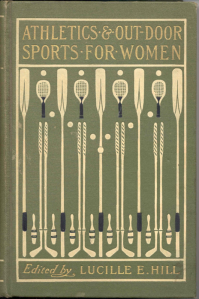I had the pleasure of doing a guest lecture in Dr. Ana Maria Garcia’s Gender in America class (at Arcadia University) this week. It was a delight to be in the classroom with inquisitive students, who asked some insightful questions and even went along with doing some physical activity during the session.
In a talk called “Doing research in women’s history — so what?”: Connections between American Women’s Athletic Activities and Their Health, I discussed my research about the ways historians use texts and illustrations drawn from popular culture to consider their educative function. Articles and advertisements that appeared in American periodicals as well as other publications at the turn of the century catalogued the advantages of women’s athletic activity and its relationship to their health.
 Popular culture sources provided an important means of informal education for their readers. They suggested that women would improve their health through physical exertion and could look forward to better posture and respiration as well as increased strength and endurance. Athletic activity could also lead to an improved complexion and a pleasant appearance. Moreover, advocates of sports for women also noted the potential benefits to society, couching their approbation in the language of race preservation. Finally, many writers reassured their audience that physical exertion provided an important balance for mental activity, frequently citing the athletic programs at women’s colleges as proof of the viability of symmetrical development. The authors of works that appeared in the popular press, unlike some writers in the medical literature, generally painted a positive image of the effects of physical activities for women, though some counseled moderation. Even some advertisements for clothing noted the relationship between appropriate attire and healthful activity for women. I argue that these sources suggested that women’s athletic activity had multiple benefits for their health and played an important role in the construction of the ideal of the new athletic woman.
Popular culture sources provided an important means of informal education for their readers. They suggested that women would improve their health through physical exertion and could look forward to better posture and respiration as well as increased strength and endurance. Athletic activity could also lead to an improved complexion and a pleasant appearance. Moreover, advocates of sports for women also noted the potential benefits to society, couching their approbation in the language of race preservation. Finally, many writers reassured their audience that physical exertion provided an important balance for mental activity, frequently citing the athletic programs at women’s colleges as proof of the viability of symmetrical development. The authors of works that appeared in the popular press, unlike some writers in the medical literature, generally painted a positive image of the effects of physical activities for women, though some counseled moderation. Even some advertisements for clothing noted the relationship between appropriate attire and healthful activity for women. I argue that these sources suggested that women’s athletic activity had multiple benefits for their health and played an important role in the construction of the ideal of the new athletic woman.
This lecture was drawn from my larger project “‘The Winning Girl’: The New Athletic Woman in American Popular Culture, 1880 – 1920,” which explores the role played by women’s athletic activity in the transformation of gender roles to determine the connections between the construction of gender and written descriptions and illustrations of athletic women.
